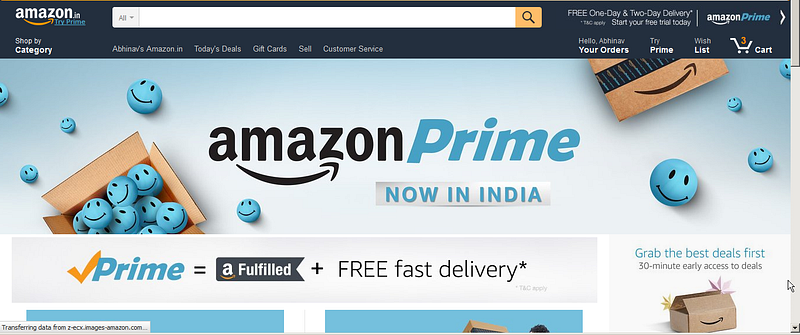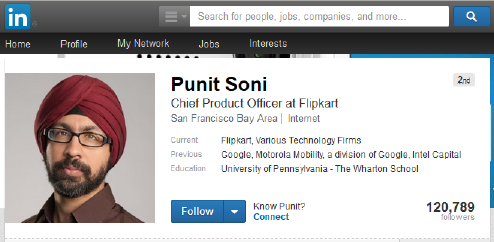C
orporate sagas seem to come in twos. The mega-fracas that erupted in 2016 between Cyrus Mistry, then Chairman of Tata Sons, and the iconic Ratan Tata, Chairman Emeritus at Tata Sons, was starting to come to a close by the second half of 2017 (though I fear the last words have yet to be written). Ratan Tata had annointed N Chandrasekaran, CEO of TCS, as thew Chairman of Tata Sons, and re-asserted his complete control over the sprawling Tata empire. Now comes the rather unexpected news that Vishal Sikka (@vsikka), CEO and MD of Indian IT behemoth Infosys, had tendered in his resignation, apparently unable to tolerate any longer the constant "drumbeat of distractions" from co-founder Mr. NRN Murthy, and, some speculated, a lack of support from some members of the Infosys Board itself.
In particular, this is what Vishal Sikka wrote in his letter to the Board:Infosys' CEO has resigned, blaming its co-founders for meddling with the business https://t.co/Nhu4PBquCF pic.twitter.com/Zp85JgGbmQ— Bloomberg Technology (@technology) August 18, 2017
"Over the last many months and quarters, we have all been besieged by false, baseless, malicious and increasingly personal attacks. Allegations that have been repeatedly proven false and baseless by multiple, independent investigations. But despite this, the attacks continue, and worse still, amplified by the very people from whom we all expected the most steadfast support in this great transformation." [link]In this perhaps altogether avoidable saga, no one has come out smelling of roses - not the Infosys board, not Vishal Sikka, and not Mr Murthy.
A Retrospect for Vishal Sikka
 |
| image credit: pexels.com |
Mr Murthy's return to Infosys had brought with it a controversy and questions of corporate governance as a result of his son Rohan Murthy's inclusion in the Chairman's office - "The presence of his son Rohan Murthy was seen to grate on several senior executives, and also did not go down too well with corporate governance experts." More on this later, because there is enough mud of poor corporate governance to be thrown at all parties here.
Products-vs-services. I wrote "...there is no company, with the arguable exception of IBM, that has achieved excellence in both services and products. Not Microsoft, not Oracle, not SAP." Infosys, under Vishal Sikka, had a decidedly uninspiring record in this area. Infosys, in early 2014, carved out EdgeVerve, a subsidiary, to focus on building "products and platforms." This continued with Vishal Sikka, and SAP veterans like Michael Reh, Anirban (Andy) Dey, Venkatesh Vaidyanathan, and others were brought in to. Even though EdgeVerve claimed to pay salaries on par with Google (and this link), it was however staffed at the middle-management layers mostly with veterans from the services side of its parent company, Infosys. The results were unsurprising - Michael Reh resigned in March 2016, Andy quit in July 2017, Venky in August 2017. EdgeVerve is rumoured to have cut its staff by as much as a fourth. Clearly, this was an area where Vishal Sikka was expected to make a substantial impact, but failed.
Vishal Sikka also had a tough time retaining talent. His record was decidedly mixed in this regard also. First, he hired as many as sixteen executives from SAP after joining Infosys. Several of them were hired at million-dollar salaries, prompting a similar raise for some of the senior executives at Infosys. Second, several Infosys veterans left, or were asked to leave, during Sikka's tenure. Eventually, several of Sikka's hires from SAP also quit, whether for personal, performance-related, or cultural-misfit reasons is not clearly known. Wherever Vishal Sikka lands next - and it is clear he is too talented, too bright a star to fade away into semi-retirement at some marquee VC firm in Silicon Valley - he will find it at least somewhat difficult to get the best and brightest to follow him.
The Infosys board will go, sooner or later. It has failed its shareholders - utterly and completely. It failed to retain its CEO. It failed to address the concerns of an angry co-founder. It failed to adequately address in time the cloud of corporate governance hanging over the company.
If the board believed in Sikka, if they had investigated the corporate governance issues (more on this later) and found everything to be above board, then why were they unable to predict or prevent Vishal's resignation? Clearly, the Infosys board was a house divided against itself, with some members rooting for Mr Murthy, and some for Vishal Sikka.
At the root of this corporate governance fracas is Infosys' decision to acquire Israeli startup, Panaya, in 2015, for $200 million (it paid $230 million, but Panaya had $30 million in cash; the net cost of the acquisition therefore was $200 million). Panaya is (or was) an Israeli start-up founded in 2010 as a cloud-based quality management service provider to enterprise applications. In the years leading to its acquisition, Panaya had "laid off more than 25% of the company. In 2016, Panaya shut down their Israeli-based sales development and moved them to Boston and the United Kingdom and replaced their CEO." [link] More pertinently, in 2013, Panaya's 4th funding round included an investment from HPV - Hasso Plattner Ventures. Hasso Plattner is a co-founder and currently Chairman of SAP. Hasso Plattner had been a friend and mentor to Vishal Sikka. This was most likely the reason for a whistleblower's letter in Feb 2017, which alleged that the deal was overpriced, that the then-CFO, Bansal, had walked out of the board meeting convened to vote on the acquisition, that there had been conflicts of interest since SAP owned a 7% stake in Panaya, and so on. The Infosys board got the allegations investigated by its internal Audit Committee as well as by Gibson Dunn and Control Risks and no issues were found. Yet the board did not make public this report.
Some basic questions remain unanswered. When Panaya emerged as a potential acquisition, the board should have asked Vishal Sikka to recuse himself from all further dealings on the matter. Neither the board nor Sikka did.
When Rajiv Bansal, then CFO of Infosys, allegedly walked out of the board meeting convened to vote on the Panaya acquisition, the board should immediately have convened a committee to look into the matter. It did not.
When co-founder Mr N.R.N. Murthy started to make allegations of corporate governance lapses at Infosys, the board should have engaged with him and put an end to the matter. It did not. The board allowed the matter to fester.
Even the letter the board released to the public after Vishal Sikka's resignation comes off as immature. It reads like a rant, a peevish outburst.
Mr N.R.N. Murthy is a legend of the Indian software industry. He has been called one of India's most influentials, one of the 12-greatest entrepreneurs of our times, and a recipient of India's second-highest civilian honour, the Padma Vibhushan.
It was Mr Murthy who came out of retirement to head Infosys as its Chairman in 2013, and in an almost magical act lured Vishal Sikka to becomes Infosys' first non-founder CEO and MD, in 2014.
Mr Murthy's ire at Infosys has been directed mostly at the board, but also, indirectly, at Vishal Sikka also. It were partly his public criticisms that prompted the board to investigate the alleged lapses in the Panaya acquisition? What makes this saga curious is that, as per the Infosys board's letter, "Mr. Murthy was interviewed as part of the investigation by Gibson Dunn and Crutcher LLP in pursuance of the investigation in the Panaya acquisition, and was invited and welcomed to provide any information or evidence he believed would support the allegations being investigated. He did not provide any evidence since none exists."
Since corporate governance lapses are what have pained Mr Murthy, it would remiss to not remind people of two incidents where Mr Murthy's judgment in matters related to corporate governance seems to have erred.
First, Mr Murthy was an independent director at media house NDTV till Sep 2009. NDTV, as may be known to people, has been in the news on account of allegations of tax fraud. Most recently, in July 2017, the Income Tax Appellate Tribunal (ITAT) upheld the Income Tax department's finding that "NDTV used their own shell companies to round-trip investments of Rs 642 crore during 2009-10, making them liable for recovery of tax and penalty." [source] NDTV's founder, Prannoy Roy, and others, were charged by the Central Bureau of Investigation under the Prevention of Corruption Act as far back as 1998. It may be an inconvenient but certainly a pertinent question if Mr Murthy were to be asked what he did, or not do, as an independent director on the board of NDTV, around these allegations and issues of corporate governance.
Second, closer to home, when Mr Murthy came back to head Infosys a second time as Chairman, in June 2013, his son, Rohan Murthy joined his father in the newly-formed Chairman's office as Executive Assistant to the Chairman. At that point Mr Murthy had emphatically stated that his son would have no leadership role in the company. Less than three months later, Mr Rohan Murthy was designated Vice President, a title that few people usually earn, and that too after fifteen or more years in the industry.
Mr Murthy's concern over corporate governance seems to be somewhat newfound. It seems conveniently expedient.
A question that does need to be asked is this - has Mr Narayan Murthy become the obsessive mother-in-law that cannot bring herself to step back? After all, Mr Murthy's once described Infosys as his "middle child". Taking that analogy one step further, Vishal Sikka was like the bride he brought home for his child. Like the stereotypical "saas" (mother-in-law) in Indian movies, Mr Murthy however could not step back and allow the "child" and "bride" to find their own way.
Mr Murthy has a legion of admirers in the industry. This battle is far from over. In this battle between Mr Murthy and Infosys - its board and ex-CEO - it is only the Infosys brand that will suffer. It would be a tragedy if Mr Murthy lets his legacy end on this sour note.
This post first appeared in LinkedIn on Aug 22, 2017.
© 2017, Abhinav Agarwal. All rights reserved.
The Board Games
 |
| [image credit: pexels] |
If the board believed in Sikka, if they had investigated the corporate governance issues (more on this later) and found everything to be above board, then why were they unable to predict or prevent Vishal's resignation? Clearly, the Infosys board was a house divided against itself, with some members rooting for Mr Murthy, and some for Vishal Sikka.
At the root of this corporate governance fracas is Infosys' decision to acquire Israeli startup, Panaya, in 2015, for $200 million (it paid $230 million, but Panaya had $30 million in cash; the net cost of the acquisition therefore was $200 million). Panaya is (or was) an Israeli start-up founded in 2010 as a cloud-based quality management service provider to enterprise applications. In the years leading to its acquisition, Panaya had "laid off more than 25% of the company. In 2016, Panaya shut down their Israeli-based sales development and moved them to Boston and the United Kingdom and replaced their CEO." [link] More pertinently, in 2013, Panaya's 4th funding round included an investment from HPV - Hasso Plattner Ventures. Hasso Plattner is a co-founder and currently Chairman of SAP. Hasso Plattner had been a friend and mentor to Vishal Sikka. This was most likely the reason for a whistleblower's letter in Feb 2017, which alleged that the deal was overpriced, that the then-CFO, Bansal, had walked out of the board meeting convened to vote on the acquisition, that there had been conflicts of interest since SAP owned a 7% stake in Panaya, and so on. The Infosys board got the allegations investigated by its internal Audit Committee as well as by Gibson Dunn and Control Risks and no issues were found. Yet the board did not make public this report.
Some basic questions remain unanswered. When Panaya emerged as a potential acquisition, the board should have asked Vishal Sikka to recuse himself from all further dealings on the matter. Neither the board nor Sikka did.
When Rajiv Bansal, then CFO of Infosys, allegedly walked out of the board meeting convened to vote on the Panaya acquisition, the board should immediately have convened a committee to look into the matter. It did not.
When co-founder Mr N.R.N. Murthy started to make allegations of corporate governance lapses at Infosys, the board should have engaged with him and put an end to the matter. It did not. The board allowed the matter to fester.
A substantial number of members of the Infosys board will go. They are on borrowed time. Who stays and who goes will be determined by who is the most astute politician.
How Do You Solve a Problem Like Mr. Murthy?
 |
| Having broken eggs, what is the omelette Mr Murthy has in mind [image credit: Pexels.com] |
It was Mr Murthy who came out of retirement to head Infosys as its Chairman in 2013, and in an almost magical act lured Vishal Sikka to becomes Infosys' first non-founder CEO and MD, in 2014.
Mr Murthy's ire at Infosys has been directed mostly at the board, but also, indirectly, at Vishal Sikka also. It were partly his public criticisms that prompted the board to investigate the alleged lapses in the Panaya acquisition? What makes this saga curious is that, as per the Infosys board's letter, "Mr. Murthy was interviewed as part of the investigation by Gibson Dunn and Crutcher LLP in pursuance of the investigation in the Panaya acquisition, and was invited and welcomed to provide any information or evidence he believed would support the allegations being investigated. He did not provide any evidence since none exists."
Since corporate governance lapses are what have pained Mr Murthy, it would remiss to not remind people of two incidents where Mr Murthy's judgment in matters related to corporate governance seems to have erred.
First, Mr Murthy was an independent director at media house NDTV till Sep 2009. NDTV, as may be known to people, has been in the news on account of allegations of tax fraud. Most recently, in July 2017, the Income Tax Appellate Tribunal (ITAT) upheld the Income Tax department's finding that "NDTV used their own shell companies to round-trip investments of Rs 642 crore during 2009-10, making them liable for recovery of tax and penalty." [source] NDTV's founder, Prannoy Roy, and others, were charged by the Central Bureau of Investigation under the Prevention of Corruption Act as far back as 1998. It may be an inconvenient but certainly a pertinent question if Mr Murthy were to be asked what he did, or not do, as an independent director on the board of NDTV, around these allegations and issues of corporate governance.
Second, closer to home, when Mr Murthy came back to head Infosys a second time as Chairman, in June 2013, his son, Rohan Murthy joined his father in the newly-formed Chairman's office as Executive Assistant to the Chairman. At that point Mr Murthy had emphatically stated that his son would have no leadership role in the company. Less than three months later, Mr Rohan Murthy was designated Vice President, a title that few people usually earn, and that too after fifteen or more years in the industry.
Mr Murthy's concern over corporate governance seems to be somewhat newfound. It seems conveniently expedient.
A question that does need to be asked is this - has Mr Narayan Murthy become the obsessive mother-in-law that cannot bring herself to step back? After all, Mr Murthy's once described Infosys as his "middle child". Taking that analogy one step further, Vishal Sikka was like the bride he brought home for his child. Like the stereotypical "saas" (mother-in-law) in Indian movies, Mr Murthy however could not step back and allow the "child" and "bride" to find their own way.
Mr Murthy has a legion of admirers in the industry. This battle is far from over. In this battle between Mr Murthy and Infosys - its board and ex-CEO - it is only the Infosys brand that will suffer. It would be a tragedy if Mr Murthy lets his legacy end on this sour note.
This post first appeared in LinkedIn on Aug 22, 2017.
© 2017, Abhinav Agarwal. All rights reserved.





















